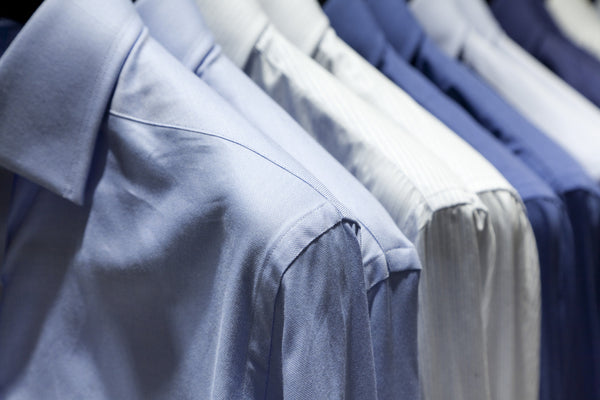Taking good care of your dress shirts can keep them looking sharp and extend their life. This includes knowing the right way to wash them, but there’s more to it. It’s also about understanding the fabric, preparing them for washing, and how you store them.
Often, we focus on the best method to wash these garments and overlook the importance of the hangers we use.
This is where Butler Luxury hangers step in. In this guide, we’ll discuss how to care for your dress shirts and highlight the role of using luxury hangers in keeping your shirts in top shape.
“The goal is not just cleanliness, it’s about taking steps to ensure your dress shirts continue to look their best for years to come. Every fabric, every stitch, and every detail matters – including how you hang them after washing.”
Understanding Dress Shirt Fabric Types and Their Care

When it comes to dress shirts, the type of material they’re made from plays a pivotal role in their care and washing regime. Let’s delve into some common materials used these garment types and the specifics tied to them:
Cotton
A common fabric for dress shirts, cotton is versatile and comfortable. Its easy-to-maintain nature makes it a favored choice. Cotton shirts can withstand high temperatures in washing and ironing but must be promptly hung after washing to prevent wrinkles.
Linen
Highly absorbent and exceptionally breathable, linen is a preferred choice for summer dress shirts. When it comes to washing, it can be laundered in a machine on a gentle cycle or hand-washed, but it’s known to wrinkle easily, making ironing crucial. Always iron while damp, centering on using a high heat setting.
Silk
Silk is synonymous with luxury, but it requires meticulous care. Dress shirts made from silk should generally be dry cleaned. However, if you’re washing at home, opt for hand washing and use a detergent specifically designed for silk. It’s also worth noting that silk should be dried naturally and ironed on a low-heat setting.
Fabric Type Influences on Washing and Care Methods

If you want your dress shirts to last, paying attention to the fabric type is critical because it heavily influences how you wash and care for them. Understanding this not only ensures your shirts’ longevity but also helps to maintain their fresh-from-the-store look.
“The fabric type of your dress shirt can drastically alter the washing and caring methods you should use.”
Cotton
Most dress shirts are cotton, which is a robust material that can stand up to almost any type of wash. However, high-quality cotton shirts should ideally be laundered rather than machine-washed. Choose a warm wash setting for colored shirts and a hot one for whites, using a gentle cycle to preserve the fabric’s integrity.
Linen
Linen shirts require gentle care. Always use cold water and a mild detergent for washing. And remember, linen tends to wrinkle – to prevent this, dry your linen shirts immediately after washing and press them while slightly damp.
Silk
Silk is a very delicate fabric and usually requires a professional cleaning service. If hand washing at home, use only cold water and a mild soap. Silk shirts should never be wrung out or twisted as it can damage the fabric. And remember to always air-dry silk shirts after washing.
Understanding and respecting the fabric type of your dress shirts when washing and caring for them is the first step in ensuring they look sharp and high quality for as long as possible.
Dress Shirt Preparation Before Washing

Preparing a dress shirt for washing is just as important as the wash itself. Proper preparatory steps can make a significant difference in the cleanliness and longevity of your dress shirts.
Removing Stains
Stains are dress shirts’ nemesis; they can creep up from nowhere and compromise your garment’s appearance and aesthetic. Familiarise yourself with the standard stain-removal methods. Most common stains like pen ink, red wine, coffee, or sweat can be pre-treated before washing.
Utilize a stain remover or a gentle dish soap to pre-treat these stains. Gently dab the stain but avoid scrubbing it as it can aggravate the stain further.
Preparing Shirts
Once you’ve dealt with any observable stains, it’s time to prepare your shirt for washing. Begin by unbuttoning all buttons, including cuff and collar buttons, to prevent undue stress on button stitching during washing. Check the pockets for any forgotten items to prevent any accidents in the wash.
Sorting is another critical aspect in preparation. Always sort your shirts by color and fabric type. Washing light-colored shirts with dark ones can cause color bleeding that could permanently stain your shirts. Similarly, washing delicate fabrics with heavy ones could damage the softer materials.
Proper preparatory steps, like dealing with stains promptly, unbuttoning the shirt, and sorting by color and fabric, can dramatically improve the quality of your wash and ultimately extend the life of your dress shirts.
Washing Techniques

After appropriately preparing your dress shirts, the next step is to wash them. This process can be accomplished via machine washing or hand washing, depending on the shirt’s fabric and your preference.
Machine Washing
When machine washing, choose the settings and detergents that best match the fabric of your shirts. Generally, it’s safer to use cool water and a gentle cycle, especially for cotton and linen shirts. Use a high-quality detergent; some detergents are specifically designed for dress shirts, and these often help maintain color and reduce fabric wear.
Hand Washing
Some shirts, especially those made of delicate fabrics like silk, may benefit from hand washing. Fill a basin with cool water and add a small amount of mild detergent.
Soak the shirt in the solution and gently agitate the water with your hands to clean the shirt. Never wring the shirt to get rid of excess water; instead, pat dry using a towel.
Up next, we will tackle drying and ironing. However, before you go, it’s crucial to know that proper care and storage don’t stop after washing and drying. Hang your clean, dry shirts on Butler Luxury’s premium hangers.
Drying and Ironing

Air Drying vs. Machine Drying
First, let’s demystify the Air Drying vs Machine Drying debate; both methods have pros and cons, but in terms of preserving your dress shirts, air drying wins by a long shot. Why, you ask?
When you air dry your dress shirts, you avoid exposing them to extreme heat and tumbling, which can lead to garment damage over time. Air drying takes longer, but your patience will pay off when your shirts last much longer.
Ironing Tips
While ironing may seem daunting, armed with the right tips, you can keep your dress shirts looking crisp and fresh.
Firstly, check the label on each shirt for specific instructions. Remember that the heat setting should align with the shirt’s fabric – cotton generally requires a high heat setting, while you would iron linen or silk shirts at a lower heat setting.
Secondly, iron your dress shirts while they’re still slightly damp; it helps dese wrinkles and promises a cleaner look.
Finally, use an iron with a steam function; it gives additional wrinkle-fighting power.
The Role of Hangers in Care and Storage

Why Invest in Quality Hangers?
Did you know hangers play a key role in extending the life of your dress shirts? Investing in top-notch hangers, like Butler Luxury hangers, helps reduce garment strain and maintain shirt shape.
Their wide shoulder pads prevent puckering on sleeve heads, a common problem with poor-quality hangers.
Features of Butler Luxury Hangers
Butler Luxury Hangers are unique. Handmade and finished with a beautiful matte varnish, they surpass common machine-made hangers in quality and aesthetics.
The hangers come with a velvet-covered trouser bar, making them perfect for not just shirts but trousers, jackets, and suits too.
Proper Hanging Techniques
When hanging your dress shirts, make sure the shirt is fully buttoned and gently smoothed out before you hang it. This helps maintain the shape and drape of the shirt. Always use one hanger per shirt and don’t overcrowd your closet.
Giving your shirts some space allows them to breathe and reduces fabric stress.
Protect Your Dress Shirts by Washing and Storing Them Properly

To recap, caring for your dress shirts is more than just knowing how to clean them—it’s understanding every facet that contributes to their care.
From washing them with suitable techniques to storing them properly on quality hangers— your shirts require an all-rounded approach to ensuring their longevity.
A dining experience isn’t complete without the perfect cutlery likewise, your wardrobe management isn’t quite done until you’ve invested in Butler Luxury Hangers. They’re not just another accessory but an indispensable part of the equation.
Elegantly crafted, they help maintain the pristine condition of your dress shirts, thus elongating their lifespan. Go ahead, spoil your shirts with the care they truly deserve.
Experience the difference with Butler Luxury Hangers by visiting their online store or Amazon storefront.






